These apps also offer educational materials. Users can purchase pet-related products and services, receive food recommendations, and participate in loyalty programs with bonus points.
The Increasing Demand for Pet Care Apps
Most pet owners strive to provide the best conditions for their animals, as they consider them an important part of their family. As a result, there is a growing interest in pet care app development services.
Modern people recognize the responsibility for their pets' health and well-being. They aim to maintain a high quality of life for their companions, and app development solutions help them achieve this. To reach this goal, it is crucial to turn to a reliable mobile app development company.
Advantages of Creating a Pet Care App
With the growing reliance on technology in pet care, the popularity of application development solutions that support the Internet of Things and artificial intelligence has surged. It is expected that this technology sector will exceed $20 billion by 2025. The rapid growth of this industry makes investing in building pet care apps profitable.
The pet clothing market is projected to reach $10 billion by 2027, driven by the increasing trend of animal humanization. This indicates significant potential for innovation and technological development in this field.
People are increasingly relying on platforms to access various services and products, such as grooming and veterinary care. The reliability of this industry and the dedication of people to their pets provide a stable market for the development of mobile apps in this niche.
Identifying Your Ideal Audience
Understanding customer needs is essential when creating a pet care mobile app. Conducting market analysis helps identify which features and capabilities are most relevant to this group of people and what they expect from the app.
Industry Trends and Customer Behavior Patterns
According to HTF Market Intelligence, the pet care app market is showing significant growth, with a projected annual growth rate of 18.14%. It is expected that the market will reach $5.47 million by 2030, a substantial increase from the current $1.70 million.
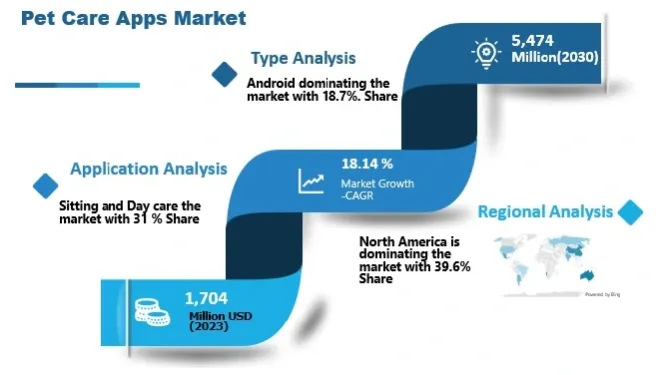
Source: HTFmarketintelligence
This is primarily due to the increasing number of pet owners worldwide. The growing population leads to a higher demand for pet care solutions, and apps provide a convenient and accessible way to manage their health and well-being.
Features such as online purchasing of pet food and pet-related products and services, scheduling appointments with veterinarians and pet service providers, and medication reminders significantly ease pet care for busy clients. Additionally, health tracker apps are becoming increasingly popular as owners invest more in pet care.
Determining User Requirements and Preferences
Pet lovers face several challenges:
finding reliable information;
maintaining medical records;
locating necessary services;
connecting with other people.
Apps help address these issues. They provide access to useful information on types of pet care, offer tools for monitoring pet health and scheduling appointments, support pet adoption and rescue, and foster community among others.
Developing Comprehensive User Profiles
In a pet care application, information about the animal is stored, such as species, color, weight, medical history, vaccination dates, and scheduled check-ups. Other important details can also be customized, such as adding a companion name and selecting its age and breed.
Creating Your App Roadmap
If you are planning pet care mobile app development, it is important to define which features it will include and what types of pet care mobile solutions it will encompass. Below is a list of various functionalities and possible categories of pet care app development solutions.
Key Functions for Pet Care Applications
A pet care app with the following key features has a competitive advantage:
Detailed profiles, including information on breed, age, weight, type, and medical history. For pet care businesses, it is crucial to support multiple profiles, as many people have several pets.
Personalized dashboards that display up-to-date information on pet health and activity. These help plan upcoming veterinary visits or medication reminders, as well as feeding and walking schedules.
Nutrition tracking and dietary management allow owners to monitor food and water intake, which helps adjust diets or detect signs of health issues.
Exercise tracking and goal setting. It can be challenging for owners to ensure their animals get enough physical activity. Integrating GPS tracking functionality for planning and tracking can help monitor distance, time, and walking speed, motivating owners and assisting businesses in creating personalized fitness plans.
GPS tracking functionality with safety features can provide peace of mind for owners. It allows for real-time tracking and the creation of virtual safe zones.
Secure storage of medical information about chronic conditions, allergies, vaccinations, and other medical details. This simplifies interactions with veterinarians and pet service providers.
Personalized notifications and reminders about veterinary appointments, vaccinations, feeding, walks, or changes in pet activity.
Interactive features. For an entertaining app development solution, functions that connect to Internet of Things (IoT) devices can dramatically change playtime. For example, the ability to remotely control a toy through the application allows interaction with pets even from a distance.
Local search and discovery of pet services, such as showing nearby veterinarians, groomers, dog parks, or emergency medical centers based on the user’s location, can significantly ease life.
Veterinary chat and video consultations provide convenient access to expert advice for minor issues. Collaborating with veterinary practices can create a convenient experience for pet owners seeking consultations and potentially generate additional revenue through telemedicine services.
First aid information for emergencies. Instructions and media files (charts, images, videos) help pet owners manage minor injuries or allergic reactions before seeking professional help.
Deciding on the Type of Pet Care Applications to Build
Among the types of apps, the following can be noted:
Pet Training Apps
These are an effective alternative to professional trainers for dog training. They provide video tutorials, images, and training tips.
Pet Walking Apps
These allow tracking of a pet’s activity during walks: distance, speed, and frequency of stops. They are equipped with GPS tracking functionality for more accurate tracking. Such apps encourage owners to pay more attention to their pets’ physical activity and health.
Monitoring Apps
These can be connected to fitness trackers or smartwatches to monitor pet health parameters: activity level, sleep quality, pulse.
Pet Health Supplements Apps
These help track animal health, including storing veterinary records in one place, conducting online consultations with veterinarians, and planning diets.
Pet Products Purchasing Platforms
TThese allow owners to buy pet-related products and services with the ability to compare prices on food, clothes, and medications.
Pet Care Programs
These apps provide a comprehensive approach to owners’ needs: they include information about pet-friendly zones (parks, restaurants, stores), product recommendations, and social features for interacting with other owners. They promote community building and provide valuable resources for improving life with furry friends.
Pet Entertainment Apps
When pets are left alone, they may become bored or feel lonely. There are many apps that help maintain their activity and mental stimulation. They offer interactive games and toys, such as feeding puzzles or sensory toys.
Pet First Aid Solutions
These provide critical assistance in emergencies. They can offer instructions on CPR, help in identifying and responding to common illnesses like poisoning or allergies. Some apps also simplify finding nearby veterinary clinics for emergency care.
Veterinary Recommendation Apps
These applications connect people with veterinary professionals and resources. Such apps ease access to veterinary services and help make informed decisions about pet care.
Crafting the App Design
This stage is crucial in the process of building a pet care app. It involves moving from initial sketches to creating a user interface with a focus on aesthetics and usability.
Pet-Centered Design Principles
Through effective visual app development solutions and compelling storytelling, companies can effectively market their products, focus on user experiences, and highlight the benefits of their services.
Resources for Creating Prototypes and Wireframes
Paper prototyping involves creating interface sketches on paper instead of using digital images.
Professional application prototype development is done using specialized software. These tools allow for quick and high-quality creation, taking into account all important details.
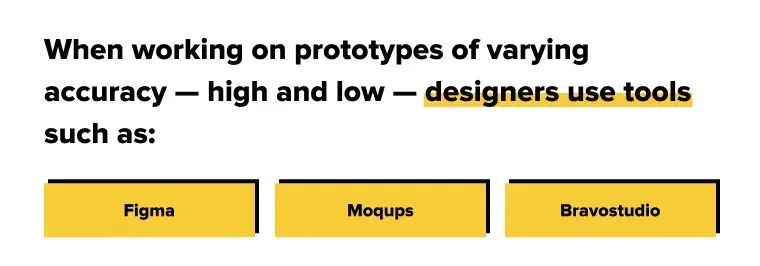
The main goal is to develop a clear action plan for developers and designers, supported by a technical specification.
Integrating Feedback into Design Refinements
Empathy maps help better understand user needs and delve deeper into the essence of the people for whom the design is being developed. They synthesize observations from the research stage and reveal unexpected user needs.
This summarizes the experience of interacting with people in design research, focusing on four main aspects: what the user said, did, thought, and felt. It is essential to carefully analyze their behavior and reactions to various actions, suggestions, and conversations.
Pet App Backend Development
Typically, the goal of the project is to create a native or cross-platform mobile app, optimize the server-side, integrate features, and build an intuitive interface. Let’s compare their capabilities.
Platform-Specific vs. Multi-Platform Pet App Development
Native mobile development involves creating code specifically optimized for a particular operating system, such as iOS or Android.
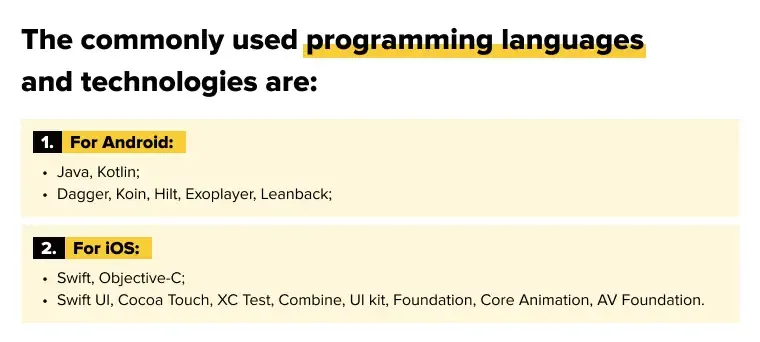
Cross-platform mobile app development is a method that allows developers to create applications that function on different mobile operating systems using a single codebase.
For pet care mobile app development, a wide range of tools and frameworks are available, among which Flutter stands out, using the Dart programming language. Technologies include Flutter Bloc, RxDart, Retrofit, Provider, Get It, GetX, and Injectable.
Additionally, the React Native framework is often chosen for creating the external interface. It provides a rich set of components for building interactive interfaces.
Which Type of Mobile App Development to Choose?
Creating a solution for different platforms is undoubtedly the best choice when there is a need to build a pet care app within a short timeframe. However, if time to market is not a critical factor, native development, with its numerous advantages, also deserves consideration. It remains a more reliable option in terms of performance and offers broader customization possibilities.
Cross-platform pet care mobile app development is more cost-effective. However, customization of cross-platform apps may incur additional long-term expenses, whereas native apps are often simpler and cheaper to adapt.
Toolset and Framework Selection
Overall, the choice of tools and frameworks for developing pet care applications depends on the type of development selected in the previous stage (native or cross-platform) and the features the application needs to have.
The technologies mentioned above are actively used by our team in working on programs. We keep up with trending frameworks and tools, implementing them in new projects.
Scalable Database and Backend Architecture
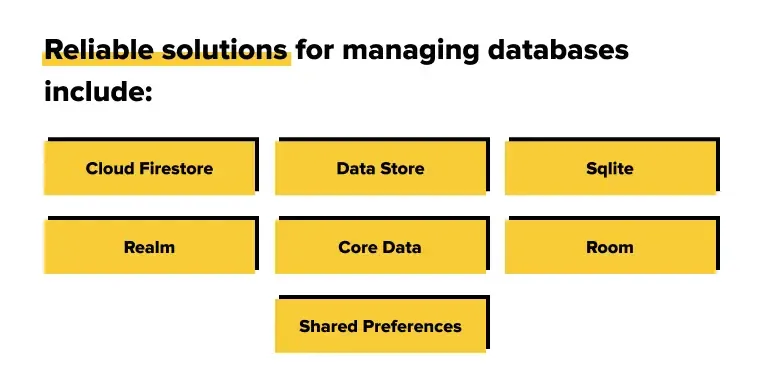
Popular architectural patterns to note are MVP, MVC, MVVM, Clean, Bloc, Viper, Redux.
Building the Application
Start the development process by creating the user interface and backend, implementing functionalities, and integrating APIs and external services.
Coding Standards
Some general coding recommendations include:
Creating clean and well-structured code with proper indentation and spacing.
Assigning meaningful and descriptive names to variables and functions.
Ensuring functions are short and focused on performing a single task.
Refactoring and reusing code to avoid duplication.
Adhering to the conventions and stylistic guidelines of the programming language.
Conducting thorough code testing and writing automated tests when possible.
Best coding practices are a set of general principles, recommendations, and standards aimed at improving the quality, maintainability, and readability of the code.
Enhancing Product Capabilities Through API Integration
Integrating external APIs for functions such as payment processing, geolocation services, and social media integration (e.g., databases for pet adoption or veterinary information) is key to enhancing the functionality and usability of the app. To ensure seamless data exchange between different components, technologies such as REST, GRPC, Sockets, JSON, SOAP, and others are used.
Creating Secure User Login and Access Controls
Implementing effective security measures, such as encryption, authentication, and authorization, is crucial for protecting user data and ensuring the integrity of the application.
Frameworks like Express.js (for Node.js) offer built-in security features, but additional tools and services can be integrated as needed to enhance security.
Conducting App Testing
This involves testing the app’s functionality and ensuring it meets performance standards.
Modular Testing and Integrated Testing
Modular tests are your primary defense against bugs. They are designed to be executed locally and verify the core parts of your code logic.
Integration tests assess how well different parts of the code interact with each other in a local environment. "Part of the code" can take various forms, but these tests typically involve checking interactions between services or APIs.
Customer Acceptance Testing
This stage of pet care mobile app development involves testing the app by the target audience or business representatives in real-world conditions. This type of testing is carried out by business users to verify that the app meets specifications based on scenarios and data reflecting actual usage conditions.
Performance Enhancement
Performance optimization is crucial for any mobile application’s success. It is important to conduct thorough testing to ensure that the app runs quickly, stably, and efficiently utilizes device resources. This allows you to create pet care apps that users will want to install and use daily.
Deploying Your App
Publishing an app on the App Store and Play Store is a complex task. Apple’s App Store has strict requirements that need to be met.
After publication, it is important to optimize the app in app stores to help target users find your app more quickly. You may need to consult digital marketing service providers to assist with app evaluation.
Final Quality Assurance and Regulatory Checks
This stage is critical in the mobile app development process: before publishing the app, it is essential to ensure that it is free of bugs.
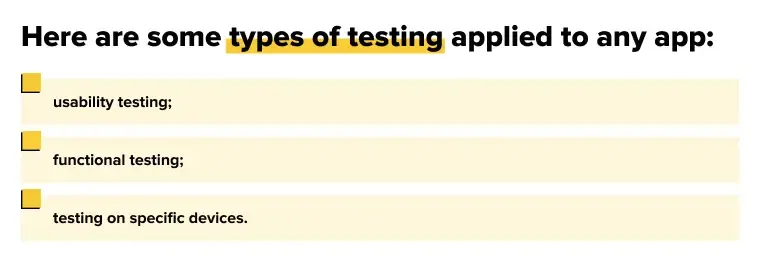
Compliance testing is the process companies use to check whether their products and services meet certain internal and external requirements or standards.
Proven Marketing Approaches
Marketing and promotion budgets are aimed at drawing users' attention to the app, increasing its visibility, and attracting new users. Expenses may include digital advertising campaigns, social media ads, influencer collaborations, and app store optimization (ASO).
SEO is a comprehensive strategy that boosts your app’s visibility in search engines. By optimizing every element, from page titles to meta tags, you create a powerful magnet for potential customers.
With Facebook Ads, your mobile pet care application can attract more customers, enhance brand recognition, and increase sales.
Managing the App Store Submission Workflow
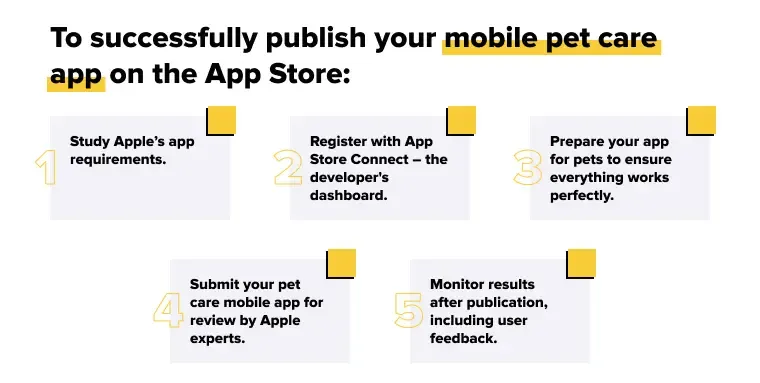
Post-Release
Provide user support after launch, gather feedback, and implement improvements to enhance the experience for pet owners and maintain their loyalty.
Analyzing App Performance and User Involvement
Promote your app through various platforms such as social media, influencers, email marketing, and paid ads to attract and retain your target audience. Monitor customer feedback.
Frequent Enhancements and System Updates
After completing pet care mobile app development, you should manage it by regularly implementing updates and monitoring their effectiveness. You can also integrate analytical tools to track user behavior and make informed decisions. Lampa Software offers post-development support to ensure smooth operation of your app.
Obtaining and Implementing User Opinions
Want your product to always meet customer expectations? Regularly collecting and analyzing feedback is a must.
To make it as effective as possible:
Continuously gather feedback to respond to changes in a timely manner.
Combine feedback with customer data to better understand why people provide specific feedback.
Create a feedback loop from data collection to implementing changes and informing users about the results.
Involve not only developers but also marketers and customer support managers in working with feedback.
Use a convenient tool to easily collect, store, and analyze feedback.
A tool is suitable if:
It integrates easily with your existing software (CRM, analytics, etc.).
It collects feedback from various sources (websites, apps, social media).
It offers feedback analysis capabilities (data visualization, segmentation).
It allows for task creation and tracking.
Remember: collecting feedback is an ongoing process, not a one-time event. Regularly analyze the data received and make changes to your product.
Summary
Pet care apps have the potential to revolutionize the approach to caring for four-legged friends. With the latest technologies, aspects of their daily lives — such as nutrition, socialization, and physical activity — are made easier.
The ideas explored in this complete guide offer solutions that will make pet care more effective, interactive, and valuable. Global pet care app development requires a range of skills, but true talent lies in identifying which features to implement. This is crucial for ensuring the app’s convenience and user-friendliness.